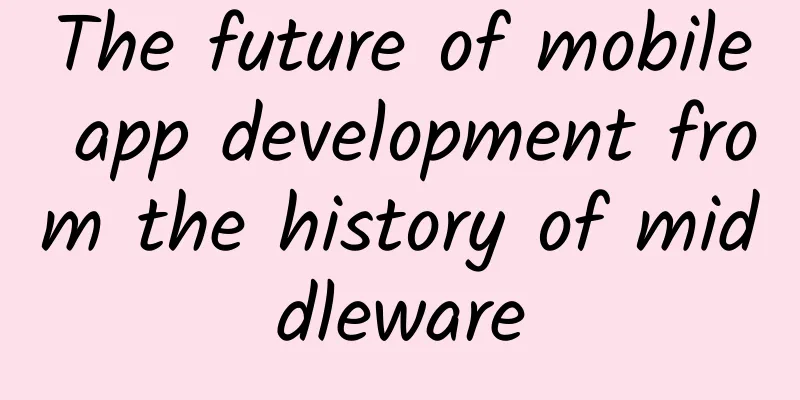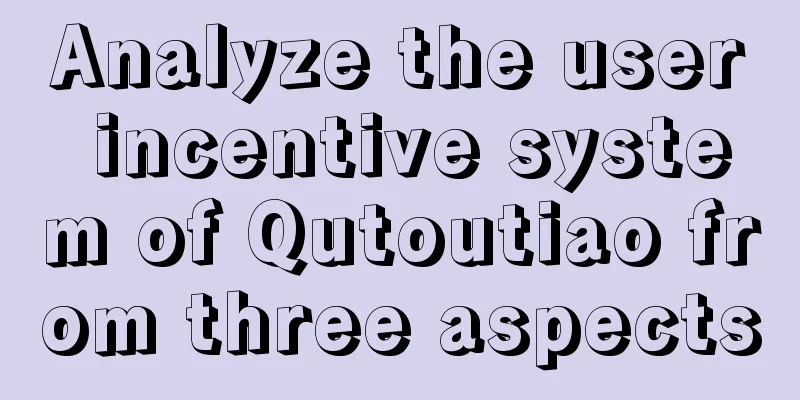The future of mobile app development from the history of middleware

|
In the field of mobile development, we found a very strange phenomenon: ordinary rookies can get a job with a salary of 8K or even tens of thousands after 3 months of training; in Beijing, iOS developers with a little work experience require a monthly salary of 20,000. I wonder if you have ever thought about this: mobile application development has been hot in the market for so many years, why do many companies still face the problem of shortage of mobile development talents? As for the reason why the growth rate of mobile development talents always cannot keep up with the development of market demand, I think it should not be simply attributed to the problem of market supply and demand. Its source power still comes from the overall development model of mobile applications and the internal factors of low development efficiency. It is this strong market demand combined with low native development efficiency that has led to a serious imbalance of talents in the software development industry in recent years, resulting in everyone having no choice but to increase wages to grab talents. For this reason, we have been looking for cost-effective application development solutions (to achieve low-cost investment and high-quality output) to reduce the complexity of application development as much as possible. The essence of application complexity is logic and control. Logic determines the lower limit of code complexity, while control includes further optimization of application environment and device environment. The most fundamental reason why we often complain that applications are not concise enough is that they fail to handle the coupling between logic and control. When it comes to decoupling application complexity, the most common solution is to separate logic and control through metalanguage abstraction, which is what people usually call middleware solutions. Let's first popularize: What is metalanguage? Simply put, metalanguage is the configuration of application syntax and semantics, and the corresponding metadata is the specific description of these configurations. In other words, meta is both data and code. In order to make this issue clear, let's briefly review the development history of middleware development technology: The earliest and most basic application development method is metaprogramming: that is, the compiler from the meta language to the target language, compiling metadata into target program code. The metaprogramming model requires us to program for specific devices. Each device will provide developers with a large number of API services based on the operating system. The final application source code is compiled and linked to generate an application that can be run directly. Although the development process is more complicated, the execution efficiency of applications generated by metaprogramming is indeed very high. Development tools that use metaprogramming include: assembly language, C language, PowerBuilder, VC, Objective-C, etc. We can understand metaprogramming through the following figure: After metaprogramming, Meta Driven Programming came up: it is an interpreter that implements the meta language directly in the target language, which is the basic way to support middleware technology. The biggest benefit of meta-driven programming is that we no longer have to program for specific devices. The meta language needs to be precompiled into intermediate code. The adaptation of the intermediate code to different types of devices can be completely handed over to the "runtime engine" to complete, thus achieving the ability of "write once and run anyway". Development tools that use meta-driven programming include: Java, Flex, .Net, etc. We can understand the model of meta-driven programming through the following figure: Meta Interpretive Programming should be more popular in recent years: it allows the meta language to run directly in different target environments, which is what we call scripting language programming. Since the compilation and pre-compilation processes are omitted, the syntax checking process of the code can only be completed during runtime. In theory, this will reduce the efficiency of application execution. However, with the continuous improvement of computer hardware performance, performance issues have been increasingly weakened. At the same time, the concise and powerful syntax of meta-interpretive programming has greatly improved the development speed of applications and reduced the complexity of programs. Development tools that use meta-interpretive programming include: Javascript, Python, Lua, etc. We can understand the model of meta-driven programming through the following figure: Why are many traditional application development rules no longer applicable in the era of mobile Internet? Let's compare the differences between mobile devices and traditional computer architectures to see what important structural changes have taken place in mobile devices. First of all, mobile devices remove the cache of the operating system. In order to control any adverse effects of individual applications on the system, when the physical memory of the application is insufficient, the application will be forced to exit immediately. This is the fundamental reason why a little memory problem will cause flashbacks in app development, and it is also one of the necessary reasons why we need to optimize app stability through underlying native programming in the project. In addition, due to the independent design of individual applications in the mobile operating system, the system-level runtime engine has nowhere to load, which naturally subverts the feasibility of meta-driven programming in app development, so programmers have to start looking for solutions to mobile middleware technology again. The programming of the new generation of mobile middleware (HTML5 Based App Programming) is a cross-platform app development model based on HTML5 technology. In this model, the native extension code is generally bridged through the embedded webkit kernel, the web UI is built with HTML5, and the business code is written in Javascript in the web page. Under this model, HTML5 technology is inherently cross-platform, and many traditional website development programmers can also naturally transition in technology. Products that use the new generation of mobile middleware model include: PhoneGap platform, Digital Paradise middleware products, Fenghuo middleware products, etc. We can understand the model of the new generation of mobile middleware products through the following figure: The development of the first generation of mobile middleware technology attracted a large number of traditional web programmers, and many people hoped to enter the app development camp through HTML5 technology. However, after a lot of attempts in the past few years, we found that the mainstream app development work in the market still had to be completed by native developers. After a few years, high-quality apps developed with Html5 are still rare in the app store. The gap between HTML5's interactive experience capabilities and native app development seems to be getting bigger and bigger. Although the rapid development of hardware devices has solved some of the problems of HTML5 page operation efficiency, the improvement of UI interaction capabilities in each major version upgrade of Android and IOS has made HTML5 technology a little bit out of reach. With the development of technology, it is natural to have an improved model for the programming technology of the first generation of mobile middleware. Its structure is shown in the following figure: The changes in the improved model are mainly reflected in two aspects: first, the native extension capabilities have been further enhanced. In addition to the expansion of local capabilities such as files, cameras, and contacts, the expansion capabilities of the native UI framework and third-party services have also been enhanced; in addition, the concept of extension modules has been added to the improved model to provide an open platform to the outside world, allowing developers to expand their own development of native components. Although the improved model has greatly enhanced the native interaction capabilities of HTML5 and native, the main technical bottleneck can still be solved, that is, the construction of basic UI can only be achieved through web pages. Developers still need to simulate native interactions through web page rendering. The only difference is that some native extension functions can be called through javascript in the web page. Products currently using the ***-generation mobile middleware improvement model include: Appcan, APICloud, HBuilder, etc. HTML5 technology is the core driving force for the development of the first generation of mobile middleware technology, but with the development of IT technology, it has also become the biggest bottleneck for the further development of mobile middleware technology. No matter how hard everyone works on the improvement model of the first generation of middleware, it can never change the single-threaded model of WebView, the complex and inefficient layout and rendering level of DOM/CSS, and the failure of the browser to achieve animation through embedded Cavas, WebGL and timers in user experience. Many people are still fantasizing that HTML5 will become the future of App. You must know that HTML5, a technology in the Web era, was not born for the mobile Internet era. HTML5 does not have the gene of mobile Internet in its bones. It is actually drifting away from the future of App. In early 2015, Facebook launched React Native, a mobile development middleware technology that completely broke away from the constraints of HTML5 in terms of structure, and truly opened the way for a framework that renders UI through custom native controls. We can call it the second generation of mobile middleware programming (Meta Extended App Programming). We can understand this model through the following figure: The "Learning once, write anywhere" proposed by Facebook in the React Native product is itself a reuse idea. Everyone is tired of various programming languages. If there is a language that can really unify the field of mobile development, it will be a good thing for everyone. Regardless of whether this framework will be recognized by the public in the future, just from the source code, there are many design ideas and implementation methods in this framework source code that are worth learning. Although the React Native product still has great deficiencies in practicality, its greatest value is that it provides a new development idea for mobile middleware technology. Perhaps many people have not paid attention to it. In mid-2015, a mobile middleware product called DeviceOne was officially released to the public. It comprehensively inherited and improved the React Native product architecture, not only realizing the "Write once, run anywhere" capability of cross-platform mobile development (supporting IOS, Android, and Windows 10 at the same time), but also realizing the complete openness of the native development extension platform. Let's study the improvement model of this second-generation mobile middleware: In the DeviceOne model, all UI component functional components have been abstracted into freely extensible cross-platform components. Even Webkit itself has been degenerated into just an ordinary UI component in the model. App developers can freely choose js scripts, lua scripts, or even python scripts to write business logic, allowing expensive native developers to focus more on underlying technology innovation and component encapsulation, and allowing application developers to focus more on the business needs of specific projects, thus achieving the separation of native development and application development, that is, fully decoupling logic and control. With the rapid development of the mobile Internet era, the demand for "low-cost and high-quality" app development technology is becoming more and more urgent. The "no silver bullet" theory expounded by Fred Brooks in The Mythical Man-Month has always had a profound impact on the IT industry: he believes that there is no technology that can improve software development by an order of magnitude in terms of productivity, reliability, and simplicity. But in my opinion, we don't have to be so pessimistic. Nothing is so absolute. Any principle has its assumed premise and scope. If it exceeds this scope, the principle may become invalid. For example: if we exceed the scope of the Big Bang base point, we will lose any reference, and even the concept of time will disappear at the same time, let alone Fred Brooks' theory? Although the "no silver bullet" theory is generally recognized in the scope of software engineering, we cannot infer that the demand for "low-cost and high-quality" is unsolvable. The development process of App development technology cannot be simply described linearly, nor will it be limited to the scope of software engineering theory. As Kevin Kelly said in "Out of Control", IT technology should be closer to the development laws of nature itself. The symbol of the industrial age is the pinnacle of mechanical design capabilities, and the new biological civilization represented by IT technology should make design return to nature again. The emergence of React native and Device one has given us new hope for app development, which may be the turning point of mobile middleware technology development that we have been looking forward to for a long time. Everything is broken before it is established. React native has achieved HTML5-free by extending tags, and Device one has further achieved decentralization while supporting cross-platform. What will the future of mobile middleware technology be like if we continue to develop in this way? Once we can stimulate the differentiated development of a large number of individuals (developers) through a distributed, bottom-up decentralized control system, we can maximize the self-learning and self-increment of the entire system. When the evolution of the system in turn affects and changes individuals, the productivity, reliability, and simplicity of software development may achieve breakthroughs in each iteration process, and even open up new growth at an exponential rate... |
<<: One picture explains whether 3D Touch is useless or a revolutionary experience
>>: Learn Swift from scratch in 30 days
Recommend
Virtual Reality Zero Distance: China's First VR/AR Conference Invites You to Participate
Virtual reality and augmented reality are high-te...
10 Mother’s Day copywriting ideas!
This Sunday, May 13th, is Mother’s Day . Are copy...
How can I make my promotion rank around the third position on the left? How do I know my PPC position?
Promotion is in the third position on the left. T...
36 rules for creating popular short videos, worth collecting!
One mode is to "pull" to the end, as lo...
Mr. Murong's BOLL indicator technical tactics
Introduction to Mr. Murong's BOLL indicator t...
Strategies for operating Douyin and attracting fans!
In the past few days, there have been many people...
Ten thousand words of dry goods summary: the most comprehensive interpretation of operational data indicators
Operations and data analysis are inseparable. Bus...
Foshan Mini Program Customization Company, how much does it cost to customize an educational mini program?
Foshan Education Mini Program Customization Price...
The new mobile app rankings for 2020 are released
The number of mobile Internet users this month re...
Tutorial on how to attract traffic with short videos on Tik Tok!
1. Register a short video platform account : If y...
Toutiao, Weibo and other 20 new media operation guides
New media operation is a series of operational me...
Four tools to double the quality of your Android code!
In this article, I will introduce how to improve ...
How to write a title with over 100,000 views? These 6 tips and 4 precautions are a must-read!
What kind of era is this? Everything is connected...
Meiyu advertising introduction and charging standards!
1. Introduction to the audience of Mayu advertisi...
Zhangjiajie Mini Program Agency Company, how much does it cost to be an agent for a luggage mini program?
How much does it cost to be an agent for a luggag...









